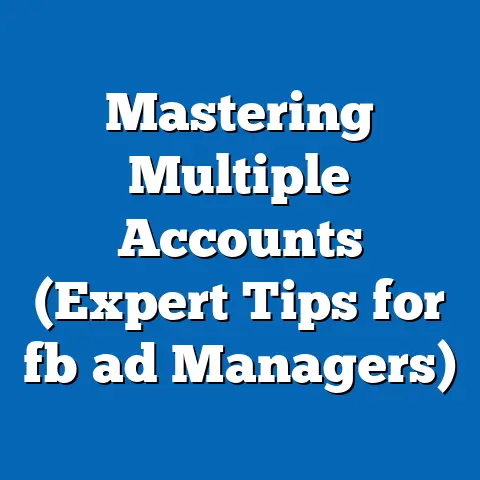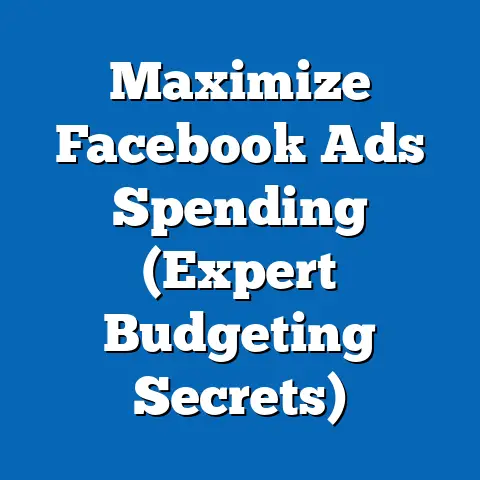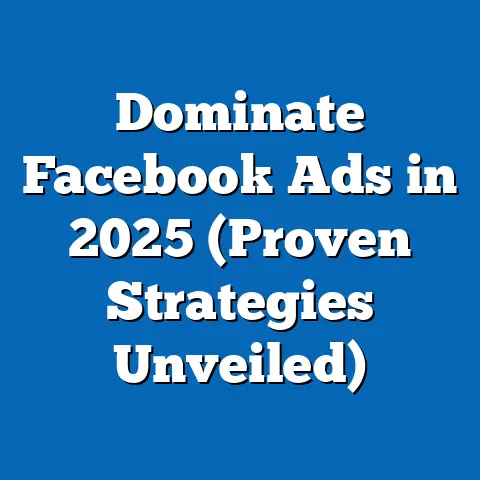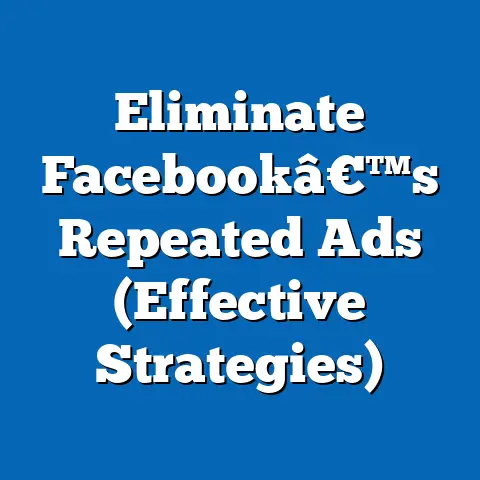Master Facebook Ads Manager in Melbourne (Insider Secrets)
Facebook advertising. It’s a beast, I know. I’ve spent countless hours navigating its ever-changing landscape, and honestly, sometimes I feel like I’m just scratching the surface. But one thing I’ve learned is this: mastering Facebook Ads Manager is absolutely crucial for any business in Melbourne looking to thrive in today’s digital world. It’s not enough to just throw some money at ads and hope for the best. You need a strategy, a deep understanding of the platform, and a few insider secrets to truly make an impact.
Here’s my expert tip, something I wish someone had hammered into my head from day one: Always start with a clear objective. Knowing whether you want to increase brand awareness, generate leads, or drive sales will dictate your entire ad strategy. It’s the foundation upon which everything else is built. Without it, you’re just wandering aimlessly through the advertising wilderness.
This article is your guide to conquering Facebook Ads Manager, specifically tailored for the unique needs and opportunities of the Melbourne market. I’m going to share my experiences, insights, and actionable strategies that I’ve honed over years of running successful campaigns for local businesses. Get ready to level up your Facebook advertising game!
1. Understanding the Facebook Ads Ecosystem
Think of Facebook Ads Manager as your central command center for all things Facebook advertising. It’s a powerful tool, and I mean powerful. It allows you to reach a massive audience, target specific demographics, and track the performance of your campaigns in real-time. But before you dive in, you need to understand the basic structure.
The Facebook Ads Manager is structured in a hierarchical manner:
- Campaigns: This is the highest level. A campaign defines your overall advertising objective, like generating leads or increasing website traffic.
- Ad Sets: Within each campaign, you have ad sets. Ad sets define your target audience, budget, schedule, and placement of your ads. Think of them as different segments of your overall campaign.
- Ads: These are the individual ads that your audience sees. They consist of the visual creative (image or video), the ad copy, and the call-to-action button.
Each objective is designed to achieve different outcomes, and understanding how to leverage them is critical. For example:
- Brand Awareness: Perfect for introducing your brand to a new audience. It focuses on showing your ad to people who are likely to remember it.
- Reach: Maximizes the number of people who see your ad. Ideal for broad campaigns with a wide target audience.
- Traffic: Drives traffic to your website or landing page. Use this if you want to get people off Facebook and onto your own platform.
- Engagement: Encourages likes, comments, shares, and other interactions with your ad. Great for building community and social proof.
- Conversions: Drives specific actions on your website, such as purchases, sign-ups, or form submissions. This is your go-to objective for generating leads and sales.
For Melbourne businesses, understanding the nuances of each objective is essential. Are you a local cafe trying to increase foot traffic? A traffic campaign targeting nearby residents might be your best bet. Are you a real estate agency looking for qualified leads? A conversion campaign with a lead generation form could be the answer.
Takeaway: Get intimately familiar with the structure of Facebook Ads Manager and the various campaign objectives. Choose the objective that aligns with your specific business goals in Melbourne.
2. Setting Up Your Account for Success
Setting up your Facebook Ads account correctly is like laying the foundation for a strong building. Skip this step, and your entire advertising structure could crumble. I’ve seen it happen too many times.
Here’s a step-by-step guide, tailored for Melbourne businesses:
- Create a Facebook Business Manager account: If you don’t already have one, head over to business.facebook.com and create a Business Manager account. This is separate from your personal Facebook profile and allows you to manage your business assets, including your Facebook Page, Instagram account, and ad accounts.
- Link your Facebook Business Page and Instagram account: Within Business Manager, add your Facebook Business Page and Instagram account. This allows you to run ads on both platforms and manage them from a single interface.
- Set up your Facebook Pixel: The Facebook Pixel is a small piece of code that you install on your website. It tracks the actions that people take on your site after clicking on your Facebook ad, such as making a purchase or filling out a form. This data is crucial for optimizing your campaigns and measuring your ROI. To set up your Pixel, go to the Events Manager within Business Manager and follow the instructions.
- Verify your domain: Verifying your domain ensures that you have control over the website you’re sending traffic to. This is important for data privacy and compliance with Facebook’s advertising policies. To verify your domain, go to the Brand Safety section within Business Manager and follow the instructions.
- Set up conversion tracking: Once your Pixel is installed, set up conversion tracking to track specific actions that people take on your website. This allows you to measure the effectiveness of your campaigns and optimize them for conversions.
Common Mistakes to Avoid:
- Using your personal Facebook account to run ads: Always use your Business Manager account. This keeps your personal and business activities separate and ensures that you have the necessary access and control over your advertising assets.
- Not installing the Facebook Pixel: This is a critical mistake. Without the Pixel, you’re flying blind. You won’t be able to track conversions, optimize your campaigns, or create retargeting audiences.
- Ignoring domain verification: This can lead to issues with data privacy and compliance. Make sure to verify your domain as soon as possible.
Takeaway: A proper account setup is paramount. Don’t rush through this process. Take the time to link your accounts, install the Pixel, verify your domain, and set up conversion tracking. This will set you up for success in the long run.
3. Targeting Your Audience Effectively
This is where the magic happens! Facebook’s targeting capabilities are incredibly powerful, allowing you to reach the exact people who are most likely to be interested in your products or services. I’ve seen campaigns explode simply by refining the target audience.
Here’s a breakdown of the different types of audiences you can create:
- Core Audiences: These are audiences based on demographics, interests, behaviors, and geographic location. You can target people based on their age, gender, education level, relationship status, interests, hobbies, purchase behavior, and more. For Melbourne businesses, you can target people who live in specific suburbs, speak certain languages, or have an interest in local events.
- Custom Audiences: These are audiences based on your existing customer data. You can upload a list of email addresses or phone numbers to create a Custom Audience of your existing customers. You can also create Custom Audiences based on website traffic, app activity, or engagement with your Facebook Page or Instagram account. This is gold for retargeting campaigns!
- Lookalike Audiences: These are audiences that are similar to your existing customers or website visitors. Facebook uses its algorithm to identify people who share similar characteristics and behaviors with your seed audience. This is a great way to expand your reach and find new customers who are likely to be interested in your products or services.
Insider Tips for Melbourne Businesses:
- Leverage geographic targeting: Melbourne is a diverse city with distinct neighborhoods. Target your ads to specific suburbs that align with your target audience. For example, if you’re a high-end fashion boutique, you might want to target residents of Toorak or South Yarra.
- Use interest-based targeting: Target people who have an interest in local events, such as the Melbourne Cup or the Australian Open. This can help you reach a highly engaged audience who are passionate about Melbourne.
- Create Custom Audiences based on your existing customer data: Upload your email list to create a Custom Audience of your existing customers. This allows you to retarget them with special offers or promotions.
- Experiment with Lookalike Audiences: Create Lookalike Audiences based on your best customers or website visitors. This can help you find new customers who are likely to be interested in your products or services.
Example:
Let’s say you own a yoga studio in Fitzroy. You could create a Core Audience targeting people aged 25-45 who live in Fitzroy, Collingwood, and Carlton and have an interest in yoga, fitness, and wellness. You could also create a Custom Audience based on your existing student list and a Lookalike Audience based on your most frequent attendees.
Takeaway: Audience targeting is crucial for the success of your Facebook ad campaigns. Take the time to define and refine your target audience using the various options available in Facebook Ads Manager. Don’t be afraid to experiment and test different audiences to see what works best for your business.
4. Crafting Compelling Ad Creative
Even the best-targeted ad will fall flat if the creative isn’t engaging. I’ve seen stunning visuals save poorly targeted campaigns, and vice versa. It’s a delicate balance, but the creative is often the first thing people see, so it needs to grab their attention.
Here are the key elements of high-performing ad creative:
- Visuals: Use high-quality images or videos that are relevant to your target audience and your product or service. Make sure your visuals are eye-catching and visually appealing.
- Copy: Write clear, concise, and compelling ad copy that highlights the benefits of your product or service. Use strong calls to action that encourage people to click on your ad.
- Call-to-Action: Use a clear and concise call-to-action button that tells people what you want them to do, such as “Shop Now,” “Learn More,” or “Sign Up.”
Examples of Successful Ad Campaigns from Melbourne Businesses:
- A local cafe: They used a high-quality photo of their signature latte with a caption that highlighted their locally sourced ingredients and cozy atmosphere. They targeted people who lived nearby and had an interest in coffee and cafes.
- A real estate agency: They used a video tour of a stunning property with a caption that highlighted the key features and benefits. They targeted people who were interested in buying or renting property in the area.
- A fashion boutique: They used a carousel ad showcasing their latest collection with a caption that highlighted the unique style and quality of their clothing. They targeted people who were interested in fashion and lived in affluent suburbs.
A/B Testing Your Creatives:
A/B testing involves creating multiple versions of your ad creative and testing them against each other to see which performs best. Test different visuals, headlines, copy, and calls to action. This is the only way to truly know what resonates with your audience.
Takeaway: Invest time and effort in creating compelling ad creative that grabs attention and resonates with your target audience. Use high-quality visuals, write clear and concise copy, and use strong calls to action. Don’t be afraid to A/B test different creatives to see what works best.
5. Budgeting and Bidding Strategies
Budgeting and bidding can feel like a black art, but it’s actually quite logical once you understand the basics. I remember starting out and feeling completely overwhelmed by the options. Don’t worry, I’ll break it down.
Budgeting Options:
- Daily Budget: This is the average amount you’re willing to spend each day on your ad campaign. Facebook will try to spend this amount each day, but it may fluctuate slightly depending on the day of the week and the performance of your ads.
- Lifetime Budget: This is the total amount you’re willing to spend on your ad campaign over its entire duration. Facebook will try to spread your budget evenly over the campaign’s duration.
Bidding Strategies:
- Cost-Per-Click (CPC): You pay each time someone clicks on your ad. This is a good option if you want to drive traffic to your website or landing page.
- Cost-Per-Impression (CPM): You pay for every 1,000 impressions of your ad. This is a good option if you want to increase brand awareness and reach a large audience.
- Cost-Per-Action (CPA): You pay each time someone takes a specific action, such as making a purchase or filling out a form. This is a good option if you want to generate leads or sales.
Insider Secrets for Optimizing Ad Spend:
- Start small and scale up: Don’t start with a large budget. Begin with a small daily budget and gradually increase it as your campaign performs well.
- Monitor your performance closely: Keep a close eye on your key metrics, such as impressions, click-through rates, and conversion rates. Adjust your budget and bidding strategy as needed.
- Use automated bidding: Facebook offers automated bidding options that can help you optimize your ad spend. Experiment with different automated bidding strategies to see which works best for your campaign.
- Consider your target audience: If you’re targeting a small, highly specific audience, you may need to bid higher to reach them. If you’re targeting a large, broad audience, you can bid lower.
- Factor in seasonality: Advertising costs can fluctuate depending on the time of year. Be prepared to adjust your budget and bidding strategy during peak seasons.
Takeaway: Budgeting and bidding are critical components of your Facebook advertising strategy. Understand the different options available and choose the ones that align with your campaign objectives. Monitor your performance closely and adjust your budget and bidding strategy as needed.
6. Analyzing and Optimizing Performance
Data is your friend! I can’t stress this enough. You can’t just launch a campaign and forget about it. You need to constantly analyze its performance and make adjustments to optimize your results.
Key Metrics to Track:
- Impressions: The number of times your ad was shown to your target audience.
- Reach: The number of unique people who saw your ad.
- Click-Through Rate (CTR): The percentage of people who clicked on your ad after seeing it.
- Conversion Rate: The percentage of people who took a desired action (e.g., made a purchase, filled out a form) after clicking on your ad.
- Cost-Per-Click (CPC): The average cost you paid for each click on your ad.
- Cost-Per-Conversion (CPA): The average cost you paid for each conversion.
- Return on Ad Spend (ROAS): The amount of revenue you generated for every dollar you spent on advertising.
Making Data-Driven Decisions:
- Identify underperforming ads: If an ad has a low CTR or conversion rate, it’s likely not resonating with your target audience. Consider pausing or replacing it with a new ad.
- Adjust your targeting: If your ads are not reaching the right people, adjust your targeting criteria. Experiment with different demographics, interests, and behaviors.
- Optimize your bidding strategy: If your CPC or CPA is too high, adjust your bidding strategy. Try lowering your bid or switching to a different bidding strategy.
- Test different ad creatives: If your ads are not performing well, test different visuals, headlines, copy, and calls to action.
- Analyze your audience demographics: See which demographics are responding best to your ads. This can help you refine your targeting and create more relevant ads.
Insider Tips for Real-Time Optimization:
- Use Facebook Analytics: Facebook Analytics provides valuable insights into your audience’s behavior and demographics. Use this data to inform your advertising strategy.
- Set up automated rules: Facebook allows you to set up automated rules that will automatically adjust your campaigns based on performance data. For example, you can set up a rule that will automatically pause an ad if its CTR falls below a certain threshold.
- Stay up-to-date on Facebook’s algorithm changes: Facebook’s algorithm is constantly changing. Stay informed about these changes and adjust your advertising strategy accordingly.
Takeaway: Analyzing and optimizing your performance is an ongoing process. Track your key metrics, make data-driven decisions, and stay up-to-date on Facebook’s algorithm changes. This will help you maximize your ROI and achieve your advertising goals.
7. Staying Ahead of the Competition
Melbourne is a competitive market, and the Facebook advertising landscape is no exception. To stand out from the crowd, you need to differentiate your campaigns and stay ahead of the curve.
Understanding the Competitive Landscape:
- Identify your competitors: Know who you’re up against. What are they doing? What are their strengths and weaknesses?
- Analyze their ads: Use the Facebook Ad Library to see what ads your competitors are running. This can give you valuable insights into their targeting, creative, and messaging.
- Monitor their performance: Use tools like SEMrush or Ahrefs to track your competitors’ website traffic, keyword rankings, and social media engagement.
Differentiating Your Campaigns:
- Use user-generated content: Feature content created by your customers in your ads. This can add authenticity and credibility to your campaigns.
- Engage with your community: Respond to comments and messages on your ads and Facebook Page. This shows that you care about your customers and are actively engaged with your community.
- Partner with local businesses: Collaborate with other local businesses on cross-promotional campaigns. This can help you reach a wider audience and build brand awareness.
- Focus on local relevance: Highlight the unique aspects of your business that are relevant to the Melbourne market.
- Stay updated on Facebook’s latest features: Facebook is constantly rolling out new features and updates. Stay informed about these changes and experiment with them to see how they can improve your campaigns.
Insider Strategies:
- Run contests and giveaways: This is a great way to generate leads and increase engagement.
- Use Facebook Live: Host live Q&A sessions or product demonstrations on Facebook Live.
- Create a Facebook Group: Build a community around your brand by creating a Facebook Group.
- Utilize Messenger ads: Engage with your customers directly through Messenger ads.
Takeaway: Staying ahead of the competition requires constant vigilance and innovation. Understand the competitive landscape, differentiate your campaigns, and stay up-to-date on Facebook’s latest features.
Conclusion
Mastering Facebook Ads Manager is an ongoing journey, but it’s one that’s well worth taking. By understanding the platform, setting up your account correctly, targeting your audience effectively, crafting compelling ad creative, optimizing your budget and bidding strategy, analyzing and optimizing your performance, and staying ahead of the competition, you can achieve significant results for your business in Melbourne.
I encourage you to implement the insider secrets I’ve shared in this article and to take proactive steps towards enhancing your Facebook advertising efforts. Don’t be afraid to experiment, test new strategies, and learn from your mistakes.
Now, I want to hear from you! What are your biggest challenges with Facebook advertising? What strategies have you found to be most effective? Share your experiences and ask questions in the comments section below. Let’s learn from each other and build a community of successful Facebook advertisers in Melbourne!






